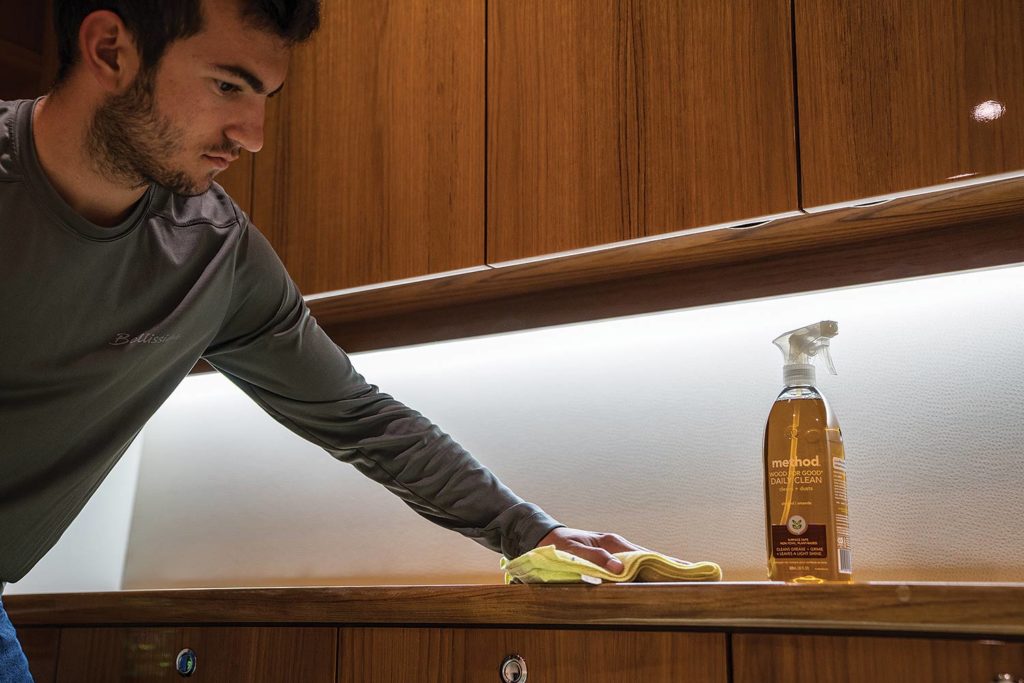
The interiors of sport-fishing yachts are an interesting space. They are beautifully handcrafted with fine attention to detail. But unlike a home, they also take a lot of abuse: The inside is shaken up all day offshore, the carpet is trampled on, and the furnishings are blasted with salt-infused air and exhaust fumes each time the salon door opens. Pile on the constant rotation of guests and crew visiting the facilities, and we have to ask ourselves: How do we keep the inside looking and smelling fresh all the time?
Basic Tips for Keeping Your Boat Clean
For new guests, it’s important to give them a rundown of what to do—and not to do—when visiting the interior spaces, such as keeping the salon door closed throughout the day. Most guests don’t understand that salt air and exhaust flood in whenever the door is open, so a little information goes a long way to save your boat’s interior.
When it’s hot outside, the air conditioning is set to colder-than-normal temperatures, and leaving the door open causes moisture to build up on the air-conditioning vents and other interior finishes—like the headliner—causing mold and mildew to grow. Interior doors and cabinets should be kept closed and latched, and be sure guests know exactly where the trash goes (spoiler alert: it does not belong in the sink). They should also know which head to use, and more important, how to use it. Directing your guests toward a dedicated day head makes cleaning up much easier at the end of a long fishing day.
Tips for Protecting Interior Finishes
When it comes to cleaning products, it’s best to limit the number of products used and to avoid harsh chemicals whenever possible. This lessens the chance of mistakenly using the wrong product. Don’t buy a different cleaner for every task. If areas need to be disinfected, then do a simple wipe-down of only the select areas. Antibacterial wipes are good for hard surfaces but do not belong anywhere near your high-gloss, varnished surfaces. Products such as Glass Plus, Murphy Oil Soap or Method’s Wood for Good Daily Clean contain no harsh chemicals and are a better fit.
Be cautious when cleaning your wood’s satin finishes too, because aggressive rubbing—or leaving greasy paw prints behind—will eventually break down the satin’s traits and leave you with a lightly “sanded” or shiny finish on what was once matte.
Watch: A Spanish mackerel is one of the world’s top marlin baits. Here’s how to rig one.
Just like the exterior of the boat, using harsh cleaners or the wrong rags or applicators will hurt your finishes over time. Spray cleaners might seem to get the job done because they’re effective at first, but they will eventually dull the finish. And always use clean microfiber towels inside; they are a lot less likely to scratch.
Many professional crews use the same products to clean their interior cabinets, showers and mirrors as their bridge enclosures. Products such as Novus, Plexus and Sumner Labs’ 210 cleaners aren’t harsh—and something you likely already have—so it’s a win-win.
If you are a spray-wax fan, using these products on your interior cabinets and shiny surfaces between fishing days requires only a quick wipe with a damp microfiber towel, followed with the swipe of a dry one to remove fingerprints. Several captains I spoke to use only vinegar diluted with Spot Zero-filtered or distilled water on a microfiber towel. Vinyl cleaners and protectants work well on headliners and salon couches, and some companies make products similar to standard wet wipes.

Tips for Maintaining and Cleaning Plumbing Systems
Marine toilets, holding tanks, and shower sump boxes need regular care and attention. Think of their maintenance as preventative so you won’t be chasing down odors constantly. A small amount of bleach combined with some Simple Green works well for things like shower boxes and gray-water tanks, but be wary. Bleach is highly corrosive if left to sit; it will break down plastic and rubber components, and corrode clamps and fittings, ultimately causing pumps and equipment to fail. So if you use it, flush the system with fresh water after use.
When the boat is loaded with guests, the holding tank fills up and creates odors if the waste sits in the tank for extended periods. Pump out the tank as soon as possible after your guests depart. Once the tank is emptied, fill it halfway with fresh water and add some holding-tank cleaner. A boat ride on a choppy day will agitate the cleaner in the tank just enough to clean it; pump it out again and flush the tank with fresh water completely.
It’s also important not to neglect your shower sump. Dirty sumps cause odors to waft up through the shower drains, and soap scum and hair accumulation will reduce the life of its components. Float switches will stick up and eventually fail, causing the shower wastewater to flood the bilge and infiltrate your clean bilge with human funk.
To clean it, turn off the pump’s breaker, pour some mild cleaner in the box, and go to lunch. When you return, use a rag to clean both the inside and the top—even taking a toothbrush to the hoses and fittings, making sure to get all scum off. Turn the breaker back on and run the hot water in the shower, making sure to flush the box completely. Filling the box with diluted Simple Green in between cleanings will keep your bilges smelling fresh—another win-win.
Read Next: When (if ever) is it acceptable to kill a marlin? Five pros sound off.
Tips for Tackling Mold, Mildew and Odors
The number-one problem with boat interiors is odor. There are several ways to prevent it, but the best way is to keep your bilges clean and dry.
Dehumidifier systems that drain themselves—set up in the shower or galley—are the best solution, but if you’re looking for something more cost-effective, charcoal briquettes (without flammable additives) put into several small plastic storage containers with holes in the lids and carefully placed throughout the boat will help. If the boat is sitting between trips, set the briquettes out on the counter in a large, sealable container with the lid off. When it’s time to go fishing, close it up and put it away. Small 110-volt ozone generators can also help with odors.
And as you can imagine, mold needs to get under control before it takes control of you. Disinfecting wipes or mildew remover sprayed on a rag is a start, but never spray it in the boat. That’s a sure way to ruin the carpet, or worse, the custom-made bedcovers and throw pillows.
In short, there really is no quick fix to handling mold, mildew and odor. The only way to deal with it is to prevent it. Doing so will have everyone jealous of how nice your boat smells—or doesn’t smell—the next time they come calling.







